I am a sucker for kitchen gadgets–for me the Williams Sonoma or Chef’s Catalog is a kind of kitchen porn. Many of them aren’t worth the trouble, but I have two onion gadgets that really work: the onion keeper and the onion dicer.
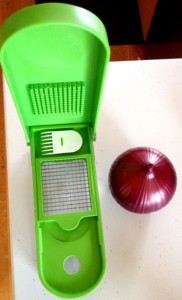 The onion keeper I picked up one day in the supermarket. It’s a plastic onion-shaped container that opens in the middle with a twist. You put an open onion in it, twist it shut, and your onion is saved without smelling up the fridge.
The onion keeper I picked up one day in the supermarket. It’s a plastic onion-shaped container that opens in the middle with a twist. You put an open onion in it, twist it shut, and your onion is saved without smelling up the fridge.
The dicer has three sets of blades, two of which (rough dice and fine dice) can handle onions. There’s also a slicer blade, which I sometimes use for mushrooms. But it’s the onion dicing that is the real timesaver, especially when you have multiple onions to dice.
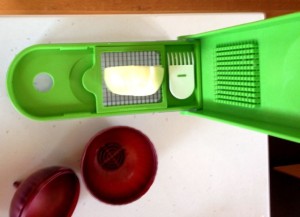 Set a half or a quarter of the onion flat side down on the dicer and pushed down the lid with your palm.
Set a half or a quarter of the onion flat side down on the dicer and pushed down the lid with your palm.
The machine gives a satisfying whump and you have instant, perfectly uniform chunks of onion.
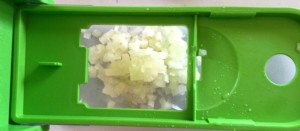 Kitchen magic! It does for onions what my corn stripper does for corn kernels. This is a little plastic module with teeth at one edge that you run along an ear of corn to remove the kernels. They slide neatly into the module, which holds just about an ear’s worth of kernels. Then you snap it apart for easy access to the kernels and easy cleaning. I tried many corn strippers before this–and this is the only one that really works.
Kitchen magic! It does for onions what my corn stripper does for corn kernels. This is a little plastic module with teeth at one edge that you run along an ear of corn to remove the kernels. They slide neatly into the module, which holds just about an ear’s worth of kernels. Then you snap it apart for easy access to the kernels and easy cleaning. I tried many corn strippers before this–and this is the only one that really works.
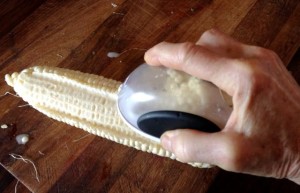
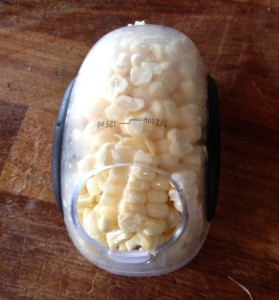 But what, you might ask at this point, does this have to do with writing and domestic tranquility? The fact is, there never used to be time for kitchen gadgets or for writing. With four children and a full time job, cooking was just a daily necessity: feed the family. Even though everyone learned to cook and had their nights as they got older, there was no time to think about gadgets. Just get out the knife and chop.
But what, you might ask at this point, does this have to do with writing and domestic tranquility? The fact is, there never used to be time for kitchen gadgets or for writing. With four children and a full time job, cooking was just a daily necessity: feed the family. Even though everyone learned to cook and had their nights as they got older, there was no time to think about gadgets. Just get out the knife and chop.
There was even less time for writing. For years, writing was last on the list. There’s a line from one of the first poems I wrote at SVCW in 1986, “I thought of you as baggage / I had to check somewhere / to write my poems.” I think it was reading Sharon Olds’ work that made me realize that domestic life could be in the poems–that and a craft talk by Bob Hass, in which he said that domestic tranquility was an almost unexplored terrain in poetry.
In the NY Times Book Review, James Parker wrote about how parenthood informed his writing: “There’s something in writing, in being a writer, that is inimical to family life. Or vice versa. P. G. Wodehouse made the point with his usual helium levity and grace by dedicating The Heart of a Goof to ‘my daughter Leonora, without whose never-failing sympathy and encouragement this book would have been finished in half the time.’ ”
Recently, the second volume of My Struggle, by the Norwegian novelist Karl Knausgaard, who has written a multi-volume account of his life, came out to great acclaim. It is a sort of minute by minute account of his life with small children. I found it unreadable–almost as dull as life with small children can be–with nothing uplifting or insightful to temper the tedium.
The best novel of domestic life I’ve read is Eliza Minot’s Brambles. I recommend it highly–a thousand times more interesting that Knausgaard. In the meantime, happy chopping and stripping and perhaps, with luck, a little writing. And just to finish this discourse, a poem by Bob Hass that illustrates domestic tranquility in a poem:
Song
Afternoon cooking in the fall sun—
who is more naked
than the man
yelling, “Hey, I’m home!”
to an empty house?
thinking because the bay is clear,
the hills in yellow heat,
& scrub oak red in gullies
that great crowds of family
should tumble from the rooms
to throw their bodies on the Papa-body,
I-am-loved.
Cat sleeps in the windowgleam,
dust motes.
On the oak table
filets of sole
stewing in the juice of tangerines,
slices of green pepper
on a bone-white dish.
Robert Hass
My spouse plus i love the Old world Kitchen. I have a house in Naples florida which i is retiring to inside 18-months. I want this kitchen look, merely don�t learn when i may afford it.